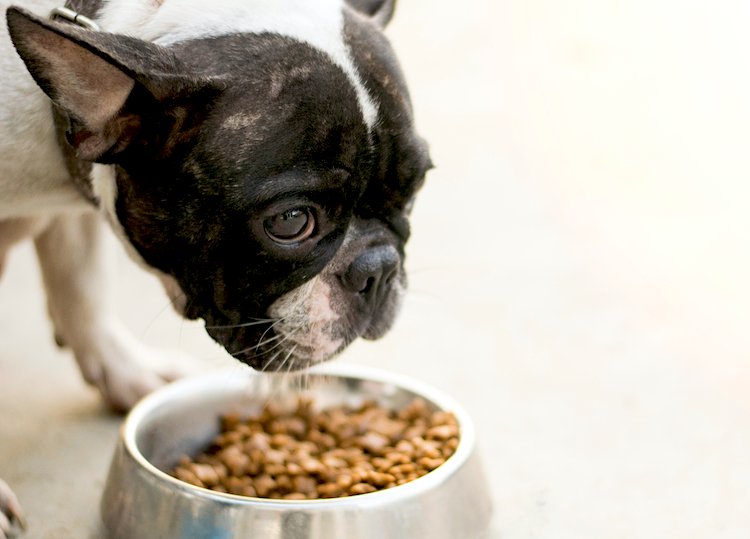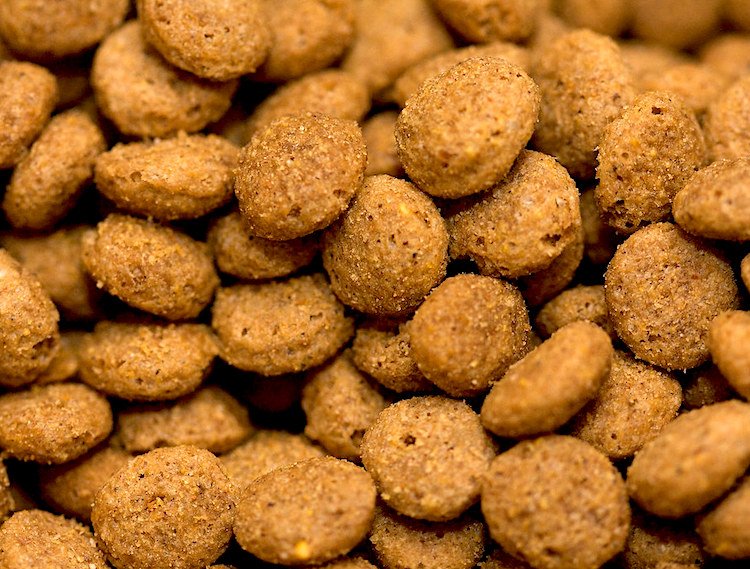
How do you switch dog food without upsetting their stomach?
My dog, Pogs, is a sidewalk scavenger — and, as a result, regularly gets diarrhea. It’s one of life’s little jokes that a dog who eats anything (digestible or not) also has a sensitive tummy.
Indeed, for many dogs even a simple change of dog food results in soft poop or diarrhea. But as the saying goes, “Forewarned is forearmed,” so here are the ins and outs of successfully transitioning your dog from one food to another.
What NOT to Do
Let’s say your dog normally eats Chicken Chow, but the store has a special on Sausage Snacks.
You decide to give your pup something different, so you fill the basket with a change of menu. After all, your dog must get pretty bored eating the same thing every day … don’t they?
Don’t change out the food all out once. Your dog may be super-excited about the new taste, but as sure as dogs have wet noses, such a sudden change will lead to a stomach upset.
Instead, switch the dog food gradually during the course of a full week, which gives your pet’s digestive system enough time to adjust.
Keep reading for specific guidance on how best to do this.

How to Switch Dog Food Gradually
There’s no big secret to switching foods. This is simply a matter of gradual change to let the gut bacteria in your dog’s digestive system adjust to the new diet.
Change from the dog’s old food to new by slowly reducing the amount of old and making up the difference with the new.
There are 2 ways to do this — and both should be done over at least 7 days:
Method 1: Mix It Up
Hide the new food amid the original food. This is a stealthy way to successfully transition fussy eaters to a new dog food.
Example Dog Food Transition Schedule
| Timeline | Directions |
|---|---|
| Days 1–2 | Replace 25% of old dog food with new. |
| Days 3–4 | Replace half of old food with new. |
| Days 5–6 | Replace 75% of old with new. |
| Day 7 | Feed entirely new food. |
Fussy eaters may benefit from an even slower transition — change out their food over a full month’s time if needed.
Method 2: Side by Side
As an alternative option, instead of mixing new and old food in the same bowl, offer them separately in bowls sitting side by side.
What’s the reasoning behind this method? Well, there’s an argument that goes: “How would we like curry mixed in with spaghetti Bolognese?” In other words, 2 different foods mixed together isn’t necessarily a winning combination.
As the days go by, keep adding a bit more to the “new food bowl” and reduce the old stuff.
Again, this should take at least 7 days to switch completely, but longer is also fine.
Was YOUR Pet Food Recalled?
Check Now: Blue Buffalo • Science Diet • Purina • Wellness • 4health • Canine Carry Outs • Friskies • Taste of the Wild • See 200+ more brands…

A Few Words About Portion Control
Just as an example, take a look at the calories in these popular dry dog foods:
- Natural Balance L.I.D. Limited Ingredient Diets Chicken & Brown Rice Dry Dog Food: 322 kcal per cup
- Blue Buffalo Life Protection Formula Adult Chicken & Brown Rice Recipe Dry Dog Food: 378 kcal per cup
That’s a 16% difference in the calorie content between 2 chicken and rice dog foods!
So, when you switch dog food, always reassess the portion size. If you were to simply keep feeding the same amount, you’d risk overfeeding (or underfeeding), causing weight gain (or loss).
If the dog’s waistline has widened, this is a good time to reduce the number of calories and put your dog on a diet. Your veterinarian or vet tech is an invaluable resource for those who aren’t sure if their pooch is pint-sized or outsized. Take the advice of a veterinary healthcare professional when in doubt.

Anticipating Stomach Upset
Changing dog food too quickly often results in an upset stomach.
But when does diarrhea stop being “expected” and start being something more worrying?
- If you see blood in the poop, at least call the vet clinic for advice. While a hint of blood may resolve itself, passing frank blood or large quantities of it can be a potentially serious sign and requires urgent veterinary assessment.
- Likewise, if the dog has watery, liquid diarrhea, they are at risk of becoming dehydrated. This is especially true if they are vomiting or not drinking — in which case the diarrhea may not be due to a change of diet. Visit the vet.
- Most dogs with diarrhea caused by a change in diet are still bright, eating well and energetic. If the dog is dull, refusing to eat or lacks energy, the digestive issues may be more complex and they should see a vet.
- Also, simple diarrhea is often self-limiting and will settle after 24–48 hours. If the diarrhea persists beyond this for several days, then it most likely needs help to firm up.
And, of course, always see the vet if you’re worried. Trust your inner instincts!
Oops! Too Late — I Already Made the Switch
If you are reading this because you switched dog foods and now your dog has diarrhea, here’s what to do.
If the dog seems fine and doesn’t need the vet (as outlined above), then withhold food for 12–24 hours. This allows the gut to rest and regroup. During this time, make sure your pet has access to plenty of fresh drinking water.
When you feed them again, offer a bland diet that is easy to digest. Suggestions include:
- Protein: White meats such as chicken breast, turkey thigh, cod or other white fish, or cottage cheese
- Carbohydrate: Boiled white rice, pasta or potato (but no added dairy, such as milk or butter)
Offer 4 small portions spread over the day, rather than 1–2 big meals. Feed this until the dog produces stool that you can pick up. Once this occurs, you can go back to once or twice daily feeding and reintroduce the new food — but gradually, as outlined above.
Doggy probiotics are also helpful. These are dietary supplements that contain the correct type of bacteria to assist a dog’s digestion. My personal preference is for FortiFlora, which has saved the day many times after Pogs’s dietary indiscretions.
However, don’t use human probiotics — the bacteria are different. Plus, many human probiotics come in a dairy drink, and the lactose in these can be a cause of dodgy tummies in dogs.

Help! My Dog Doesn’t Like the New Food
There are many reasons you might decide to switch your dog’s food.
Sometimes a change of life stage (puppy to adult, or adult to senior) requires a change of food. Or you may wish to switch from a dry food to a fresh dog food. Or perhaps the dog has a medical condition requiring a special prescription food.
If your dog turns up their nose at the new ration, the following suggestions may help.
- Take it slow: A fussy eater may object not only to a new taste, but also to a new texture or smell. Transition them very slowly so they become accustomed to the different sensory experience of the new food.
- Warm the food up: This can work for wet or canned foods. Warming it gently can make it more appealing and release some of the tempting food smells to stimulate your dog’s appetite. For dry food, you may wish to add a little gravy (be careful to select a low-salt variety and no onion gravy) or the water from some boiled fish.
- Give a fresh portion each meal: If the dog refuses the food, reduce the portion size, but offer fresh each meal. Also, pick the food bowl up between meals. This helps them realize that if they don’t eat the food, it disappears until the next mealtime.
- Sprinkle a probiotic over the food: Again, FortiFlora is tasty stuff for dogs and will tempt some fussy eaters to tuck in.
- Don’t make a fuss: Don’t stand and watch, biting your nails, waiting for your pup to eat. Instead, leave the room. To do so removes the potential for your concern to accidentally reward the dog for not eating.
Follow these tips next time you need to change dog food and all should be well. But remember, see a veterinarian if your gut instinct (see what I did there?) says something’s wrong.
References
- Dressman, Jennifer B., BPharm, PhD. “Comparison of Canine and Human Gastrointestinal Physiology.” Pharmaceutical Research 3, no. 3 (1986): 123–131. https://deepblue.lib.umich.edu/bitstream/handle/2027.42/41512/11095_2004_Article_306447.pdf?sequence=1.
- Tremayne, Jessica. “Prebiotics, Probiotics and Intestinal Health.” Veterinary Practice News. Sept. 27, 2012. https://www.veterinarypracticenews.com/prebiotics-probiotics-and-intestinal-health/.
- Stilwell, Natalie, DVM, PhD. “Immune-Stimulating Properties of Probiotics.” American Veterinarian. Oct. 5, 2018. https://www.americanveterinarian.com/journals/amvet/2018/october2018/immunestimulating-properties-of-probiotics.
- “Tips & Methods for Switching Dog Foods.” Hill’s Pet Nutrition. July 3, 2019. https://www.hillspet.co.uk/dog-care/nutrition-feeding/how-to-transition-my-dogs-food.
- “The Right Way to Switch Dog Foods.” American Kennel Club. July 8, 2019. https://www.akc.org/expert-advice/nutrition/right-way-switch-dog-foods/.
 This pet health content was written by a veterinarian, Dr. Pippa Elliott, BVMS, MRCVS. This article was originally published in 2012 and is regularly updated. It was last reviewed for accuracy and updated July 10, 2023.
This pet health content was written by a veterinarian, Dr. Pippa Elliott, BVMS, MRCVS. This article was originally published in 2012 and is regularly updated. It was last reviewed for accuracy and updated July 10, 2023. 

